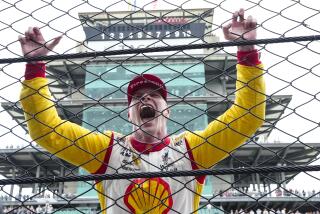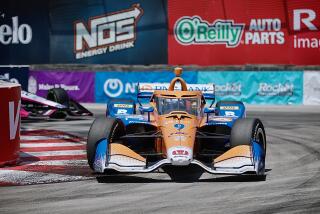Quick Study : Signed as a Test Driver Two Years Ago, Paul Tracy, 24, Won at Long Beach Last Month and Is Among Favorites to Win Indy 500
- Share via
INDIANAPOLIS — Paul Tracy sat on a curb in Long Beach in April of 1991, dejectedly mulling over his first Indy car race, when Roger Penske rode by on a bicycle.
“Roger stopped and said, ‘Great job.’ It made me really feel good,” Tracy recalled.
The young Canadian had qualified well with a two-year-old rented car, but got caught in a first-turn jam and fell back to the rear of the field. He moved up in the field until a water line broke after 30 laps.
“I had begun to doubt myself, and then to drop out that way, I was feeling low,” Tracy said. “I had won everything in Indy Lights (the previous year), but it led to nothing. I was going to races out of my parents’ bank account, and my dad was about tapped out.
“He had to borrow money for me to get a car from Dale Coyne to run in the Long Beach Grand Prix, hoping maybe we could pick up a sponsor. Then Roger talked to me after the race, and the day after qualifying at Indy he signed me to a contract. That was just two years ago. I can’t believe how things have changed since then.”
Tracy was hired as a test driver, but when four-time Indy 500 winner Rick Mears had wrist
surgery after the Indianapolis race last year, Tracy was called on to fill in for his injured teammate and he responded by winning the pole at Elkhart Lake and finishing second in the Michigan 500.
When Mears shocked the racing world by retiring at the Penske team’s Christmas party last December, Tracy joined Emerson Fittipaldi as a team driver. After his impressive outing in Phoenix and his victory a month ago in the Long Beach Grand Prix, he finds himself one of the favorites for this year’s Indianapolis 500.
He will take the first step today when four-lap time trials determine the pole sitter and the front of the starting field for the May 30 race.
And Tracy, despite his insistence that the Fords will be at an advantage during the four-lap time trials, has consistently been one of the fastest cars all month in his Chevrolet-powered Penske. Tracy’s fastest lap, 224.389 m.p.h., was seventh fastest in practice this month.
The fact that he is heir to the mantle of Mears alone would seem to make him a contender. Mears won a record six poles at Indianapolis and started from the front row a record 11 times in 15 years.
“There was always pressure for Rick to qualify on the pole, just because he did it so often,” Tracy said. “In terms of pressure on me, I’m not in the same situation. If I can get in the first three or four rows, I’ll be happy. Then I’ll get on with preparing for the race.”
Mears, now Tracy’s tutor in his role as an elder statesman for the Penske team, agrees.
“Right now, as far as I am concerned, I think Paul’s big concern is the race, not qualifying,” Mears said. “We’ve been working more on the race setup, getting Paul comfortable with the car. For qualifying, let it happen, however it’s going to happen.
“You know, if things are working, you have a shot at it. But I wouldn’t risk anything in qualifying. The race is the important part.”
The parallels in the careers of Tracy, a bespectacled 24-year-old from the suburbs of Toronto, and Mears, 41, the bearded veteran from Bakersfield, are remarkable.
Penske found Mears during a motorcycle ride through Colorado in 1977. A year later, Mears sat in the front row at Indianapolis. And a year after that, he sat on the pole and won the 500.
Mears was 25 when Penske signed him to fill in for Mario Andretti while Andretti was away winning the Formula One championship. When Andretti switched teams in 1979, Mears joined Bobby Unser as Penske team drivers.
Mears won his first Indy car race in his 15th start, at Milwaukee in 1978. Tracy won his first in his 18th start.
“Winning my first race should take a little pressure off, pressure I was putting on myself,” Tracy said. “I wanted to win so badly, to show everybody what I could do, that sometimes I tried to do too much.
“They say that once you win your first one, the next one comes easier. I hope to find that out.”
There is one major difference between Mears and Tracy--their driving styles. Mears was a patient driver who laid back, protecting his machine, until late in the race. Tracy is more aggressive, a go-for-the-lead driver more in the mold of Mario Andretti or Parnelli Jones.
One of Mears’ projects has been to tone down his protege--but only a little.
“Paul is good, very good,” Mears said. “Sometimes I watch him and I see him doing things I wish I could have done. I would like to have been more aggressive, like my brother Roger, or Parnelli, who was sort of my tutor when I first started racing in the desert.
“But I told Tracy some time ago, ‘Paul, you’re going to realize one of these days that you can slow down and still go faster than anyone else and you can take two or three percent off and you may end up going faster by running easier and still be able to win races.’ I think he’s beginning to realize that now.
“What he’s got--that can’t be taught--is a natural feel for cornering. I’ve seen aggressive, bold drivers who can’t get through a corner right. Paul knows how to do that. He has the natural ability to run a car quick and more important, how to make passes in traffic. That’s the tough part, and he does it easily.”
Tracy has led 232 of 370 laps in this year’s three races. He dominated the Valvoline 200 at Phoenix, lapping the field twice before getting involved in an accident with Jimmy Vasser.
Tracy’s version: “I was in the groove, but running at that kind of a pace, there is no sense in trying to slow down. It only upsets the pace and you lose your concentration. I made the mistake of trusting the guy to let me go. I went low and he didn’t see me and suddenly I was out of racetrack.
“I tried to focus more on lapped cars at Long Beach. It was a lesson learned, but I think it’s unfair to say that I am too aggressive. To run up front in the caliber of the fields we have, you have to be aggressive.”
The way Mears saw it: “I think Paul did not have to put himself in that position, and he knows that. We talked about that, but if you go back and look at the whole thing, I watched him catch guys all along, whether it was (Bobby) Rahal or Junior (Al Unser Jr.) or any of those guys. He’d come up behind them and they were going down the straightaway and they pulled out and watched in the mirrors.
“He caught Vasser. He had run behind him for a couple of laps. They were giving the (move-over) flag, Vasser wasn’t moving over and Paul was getting antsy. When you’ve been running 21-, 22-second laps and suddenly you’re down to 25, 26 seconds, it feels like you’re parked.
“I’ve watched the replay. When Vasser entered the turn high, extremely high, Paul saw that and thought ‘OK, I’ve been trailing for two laps, he’s opening the door for me now,’ and then all of a sudden, here came Vasser back down the track and Paul’s committed and there’s no place to go.
“Obviously, Paul could have run 26-second laps the rest of the day and still won it. I didn’t need to lean on him afterward. He knew what happened and he was probably upset with himself, with Vasser, with the fact he still hadn’t won his first race. I just told him that he had done a hell of a job and it was an unfortunate deal.”
Tracy had led 150 of the 200 laps when he spun at Phoenix. At Long Beach, he led 81 of 104 laps while swapping the lead three times with Nigel Mansell.
After that first victory, he got a note from the boss.
“Roger told me I did a great job, that when I had to drop back with those two flat tires, he was proud of me that I didn’t give up. Then he wrote, ‘Hey, you beat the world champion.’ It really gave me a lift, but now I’ve got to focus on more than just the world champion (Mansell). There’ll be 30 other guys out there wanting to win, too.”
More to Read
Go beyond the scoreboard
Get the latest on L.A.'s teams in the daily Sports Report newsletter.
You may occasionally receive promotional content from the Los Angeles Times.










